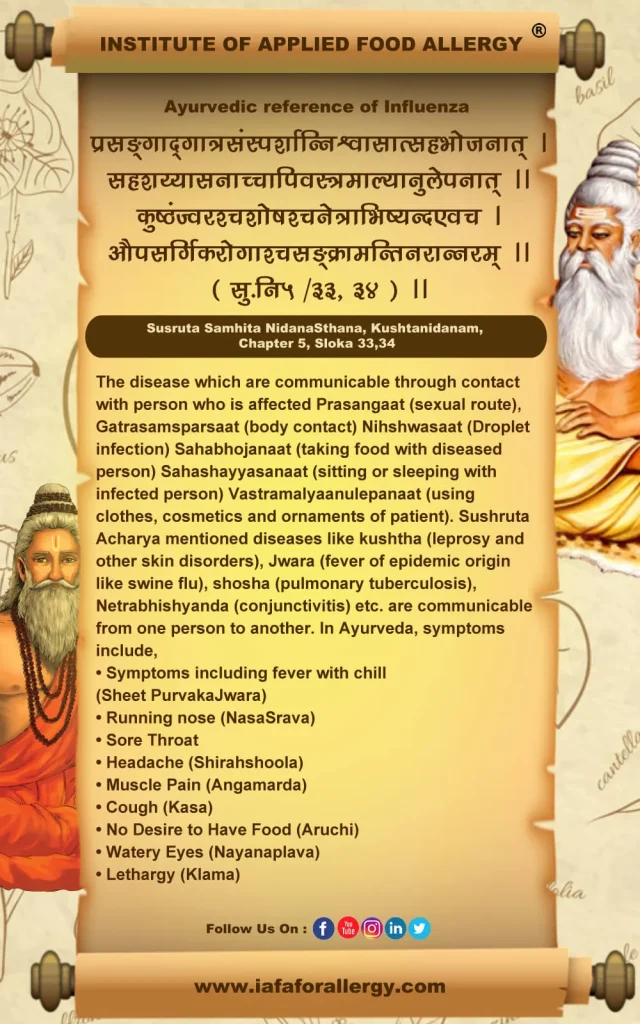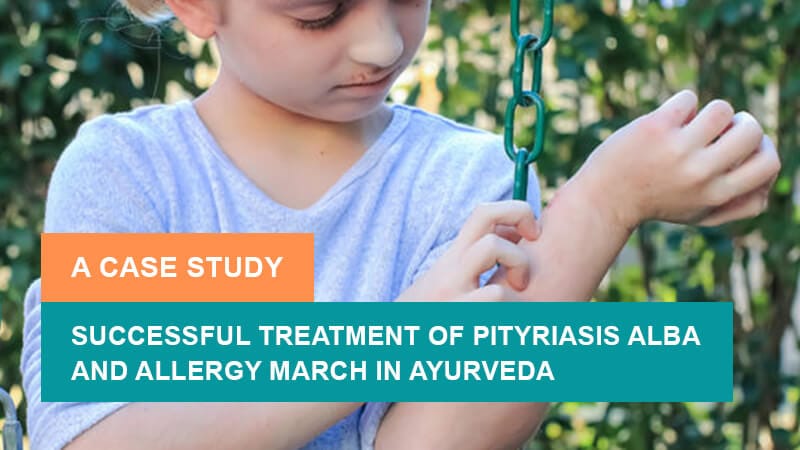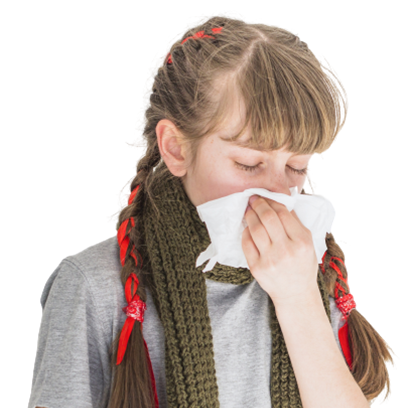On This Page
Influenza – Aupsargikaroga-Samsargajaroga
प्रसङ्गाद्गात्रसंस्पर्शान्निश्वासात्सहभोजनात् ।
सहशय्यासनाच्चापिवस्त्रमाल्यानुलेपनात् ।।
कुष्ठंज्वरश्चशोषश्चनेत्राभिष्यन्दएवच ।
औपसर्गिकरोगाश्चसङ्क्रामन्तिनरान्नरम् ।।
Influenza (flu) is an acute respiratory illness caused by infection with influenza virus. It affects the upper and lower respiratory tract and is often accompanied by systemic signs and symptoms such as fever, headache, myalgia and weakness. Flu viruses are divided into 3 types as Influenza types A and B and Influenza Type C and differs in severity of the disease. Most children are ill with the flu for less than a week. But some children have a more serious illness and may need to be treated in the hospital. The flu may also lead to lung infection (pneumonia) or death.
In Ayurveda, it may be defined as Aupsargikaroga/Samsargajaroga (communicable disease). The disease which are communicable due to history of contact with person who is affected. According to Charaka Acharya, though individual persons differ widely in physical health and vitality, they are collectively liable to devastating epidemics (that is Janapadodwansa) caused by external factor that is Bhutabhisangaja- (influenza virus)
Causes of Influenza
Influenza is a respiratory infection that can be caused by a variety of influenza viruses. There are three families of influenza virus: A, B, and C. Viruses that cause influenza spread from person to person mainly by droplets of respiratory fluids sent through the air when someone infected with the virus coughs or sneezes.
Symptoms of Influenza
The flu is a respiratory disease, but it can affect the whole body. A child can become suddenly ill with any or all of these symptoms:
- Fever, which may be as high as 103°F (39.4°C) to 105°F (40.5°C)
- Body aches, which may be severe
- Headache
- Sore throat
- Cough that gets worse
- Tiredness
- Runny or stuffy nose
In some cases, your child may also have symptoms such as:
- Vomiting
- Diarrhea
- Nausea
In Ayurveda, symptoms include,
- Symptoms including fever with chill (Sheet Purvaka Jwara)
- Running nose (NasaSrava)
- Sore Throat
- Headache (Shirahshoola)
- Cough (Kasa)
- No Desire to Have Food (Aruchi)
- Watery Eyes (Nayanaplava)
Ayurvedic Reference of Influenza- Aupsargikaroga-Samsargajaroga


“At Dr. Gupta’s IAFA, we are providing very effective treatment for Influenza in children based on the classical principle of Ayurveda and our research. Institute of Applied Food Allergy® ensures that our health care system better meets the needs of all about your child’s health”.
Not just better healthcare, but a better healthcare experience!!! Dr. Gupta’s IAFA for your child’s future
– Dr. Sahil Gupta (B.A.M.S., M.H.A.)
Ayurvedic Allergy Specialist
CEO & Founder of IAFA®
At last, Easier Influenza Management

Trusted by
More than 90,000 Patients

Convenient
at-Home Treatments

9.2 / 10
Customer Satisfaction Score
Ayurvedic Treatment for Influenza
We can prevent the spread of influenza by strengthening the Ojas and enhancing our body immunity. The treatment can be divided in following steps like Nidana Parivarjana (removing the causative factors through diet and lifestyle regimens), Samana (Palliative), Sodhana (Purificatory), and Rasayana (rejuvenative) therapies.
Internal Medicines for Influenza
Uncomplicated Cases
- Shadangapanam
- Pachanamrta Kashaya
- Laxmivilasa rasa
- Medicated coffee
- Vaporization with tulasi leaves
Respiratory Signs Predominance
- Pathyakusthumbaradi Kashaya
- Laxmivilasa rasa
Febrile Predominance
- Amrtotharam Kashaya
- Sudarsanamgulika
- Sa suntipeya (gruel with dried ginger)
Purificatory Therapies for Influenza
In Ayurveda certain conditions of Jwara (fever) some Panchakarama (purificatory therapies) i.e., Vamana, Virechana, Vasthi, Nasya, etc. are indicated depending on doshic strategy and their contraindications. They can be applied in Influenza management depending upon the condition of patient and disease.
Single Herbs Used in for Influenza
- Amalaki (Emblica officinalis)
- Guduchi (Tinospora cordifolia)
- Ashwagandha (Withania somnifera)
- Shatavari (Asparagus racemosus)
- Yashtimadhu (Glycyrrhiza glabra)
- Kutaki (Picrorhiza kurroa)
- Punarnava (Boerhaavia diffusa)
- Tulsi (Ocimum sanctum)
- Bhumyamalki (Phyllanthus niruri)
- Chitraka (Plumbago zeylanica)
- Nimba (Azadirachta indica)
- Haridra (Curcuma longa)
Diet in Influenza
Pathya (Do’s)
- Handwashing is the most important way to reduce the spread of flu
- Teach children to cover their noses and mouths with tissues when sneezing or coughing, to put used tissue in a wastebasket immediately, and to wash their hands after wiping their nose or handling tissues.
- If a family member has the flu, clean surfaces (such as toys, bathroom taps and doorknobs) after the ill person has touched them.
- If your child attends daycare, tell the caregiver if you think your child has influenza. Keep your child at home, away from daycare or school, until the fever is gone and she is feeling better.
- Ahara (Food): ShadangaPaniya (medicated water prepared by Musta, Parpataka, Ushira, Chandana, Nagara, Udichya), Tarpana prepared of the LajaSaktu (Churna of perched paddy) mixed with honey, sugar and juices of fruits, Yavagu (gruel), odana (boiled rice) and Laja (popped or perched paddy), Peya(gruel) prepared with Laja
- Vihara (Life style): complete bed rest, staying in well ventilated room with hygienic condition
Apathya (Don’ts)
- Ahara: Heavy food, curd, green peas, black eyed beans, lentils, yellow gram, black gram, raw vegetables and salads, refined foods such as white flour (Maida), contaminated water or food, sprouts, cold food and beverages, junk foods, fried food, bakery items.
- Vihara: Physical and mental exertion like physical exercises, exposure to cold, breeze, suppression of natural urges, taking bath with cold water etc.
Yoga Therapy for Influenza
The deep breathing techniques and postures in yoga can lower your body temperature and alleviate discomfort.
Postures include:-
- Matsyendrasana
- Sarvangasana
Pranayama include:-
- Nadi Shodhan Pranayam
- Anulom Vilom Pranayama
- Kapalbhati pranayama

Frequently Asked Questions
Question: What is Influenza?
Answer: An acute respiratory illness caused by infection with influenza virus which affects the upper and lower respiratory tract and is often accompanied by systemic signs and symptoms such as fever, headache, myalgia and weakness
Question: What are the causes ofInfluenza?
Answer: An acute respiratory illness caused by infection with influenza viruses of various types.
Question: What is the Ayurvedic treatment for Influenza?
Answer: Ayurveda treatment of Jwara includes dietary and lifestyle regulations along with drugs having anti-viral, cleansing and antioxidant properties. They are excellent for balancing Vata and Kapha, which are the prominent Dosha in Influenza or any other respiratory tract infections.
At Dr. Gupta’s IAFA, we are providing very effective treatment for Influenza in children based on the classical principle of Ayurveda and our research. IAFA ensures that our health care system better meets the needs of all about your child’s health.
Not just better healthcare, but a better healthcare experience!!! Dr. Gupta’s IAFA for your child’s future
Was this Page Helpful?
So IAFA Ayurvedic Management for Influenza in Children is Just 3 Steps Away!

01. Connect With Us
Book an appointment to share queries of your child health.

02. Consult With Us
Consult with Ayurvedic Pediatrician of IAFA®.

03. Root Cause Treatment
Get an accurate diagnosis and treatment for your child.
Influenza – Case Studies
Real Case Studies of Successfully Treated Patients from All Around the World by IAFA Ayurveda®
-

Successful Treatment of Pityriasis Alba and Allergy March in Ayurveda – A Case Study
It is a case study about successful treatment of Pityriasis Alba and…
-

Successful Treatment of Gallstones (Cholelithiasis) with Ayurvedic Medications – A Case Study
It is a case study about the successful treatment of Gallstones (Cholelithiasis)…
-

48-Year-Old Male Patient Got Relief from Chronic Aspergillosis of Paranasal Sinuses – A Case Study
Fungal infections can be treated with a high success rate by various…
-

6-Year-Old Child Patient Got Relief from Gluten Intolerance and Wheat Allergy – A Case Study
It is a case study of a 6-year-old Child Patient who got…
Read More Articles
-
-
-

Attention Deficit Hyperactivity Disorder – ADHD (Vatika Unmada)
So IAFA Root-Cause Treatment of Your Attention Deficit Hyperactivity Disorder is Just…










